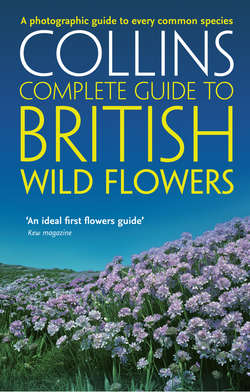Читать книгу British Wild Flowers: A photographic guide to every common species - Paul Sterry - Страница 5
ОглавлениеINTRODUCTION
PEOPLE LIVING IN BRITAIN and Ireland seldom have to travel far to find a wealth of wild flowers and, although the region’sv plantlife faces significant conservation issues, residents should feel privileged to live in such a flower-rich part of the world. Underpinning our floral diversity is a rich array of habitats, the product of our region’s topography, geology and history of land use. Good fortune, in the form of the Gulf Stream, dictates a mild and comparatively equable climate for much of the time, and this, too, contributes to botanical diversity. Complete British Wild Flowers has arisen from my personal love for the flora of Britain and Ireland, not to mention half a lifetime devoted to photographing our wild flowers.
THE REGION COVERED BY THIS BOOK
The region covered by this book comprises the whole of mainland England, Wales, Scotland and Ireland, as well as offshore islands including the Shetlands, Orkneys, Hebrides, Isle of Man and the Isles of Scilly. In addition, I have included the Channel Islands because their proximity to, and ecological affinities with, northern France allow them to make a valuable contribution to our flora.
THE CHOICE OF SPECIES
The coverage of the book is restricted mainly to what most people understand to be wild flowers – not a strict botanical term, but taken to mean flowering plants of relatively modest stature, species that in most cases do not exceed 2m in height. For the sake of completeness I have also included a number of woody flowering shrubs, but I have excluded obvious tree species. Terrestrial habitats harbour the lion’s share of our flowering plants and this is reflected in the coverage of this book. But I have also included species that are strictly aquatic, both those that occur in freshwater habitats and the limited range of flowering plants that grow in coastal marine environments.
Complete British Wild Flowers is aimed primarily at the botanical novice and those with a moderate degree of botanical experience. Consequently, for the main section of the book, I have selected species that the naturalist stands a reasonable chance of encountering, although a few scarce but spectacular and distinctive species have also been included here for good measure. Some botanical groups are minefields for the beginner: for example, hundreds of so-called ‘microspecies’ of brambles are recognised by experts and similar complexity is found among dandelions, hawkweeds and eyebrights to name three more. In a book of this size, accurate identification of these subdivisions is impossible to achieve. So rather than baffle the reader, I have chosen to ‘lump’ the subdivisions together within these complex groups and treat them as species aggregates.
In the hope and expectation that readers’ appetites for botanical discoveries are whetted by the book, the last section of Complete British Wild Flowers is devoted to botanical hotspots, areas that merit a visit in search of the localised floral treasures they harbour.
Floral delights such as this heathland have inspired generations of botanists.
